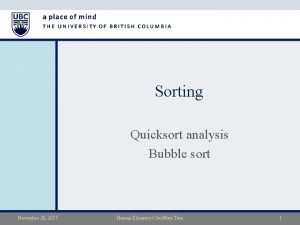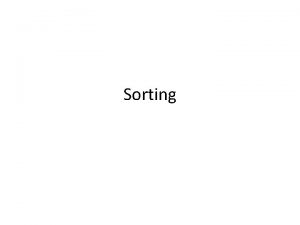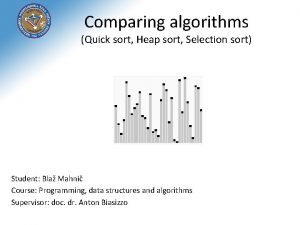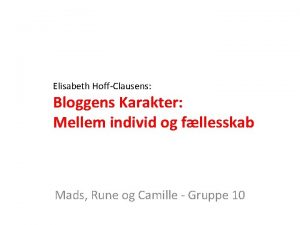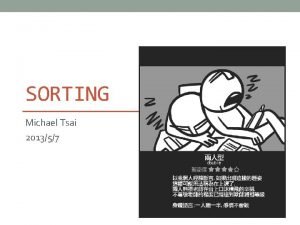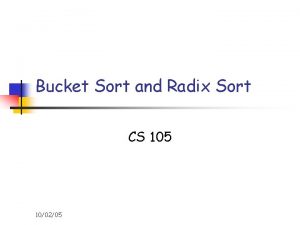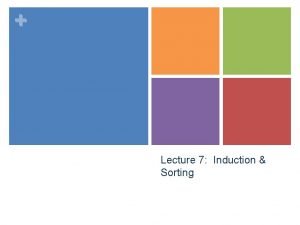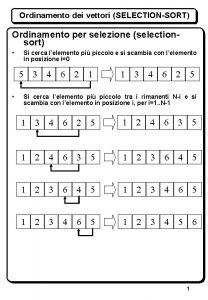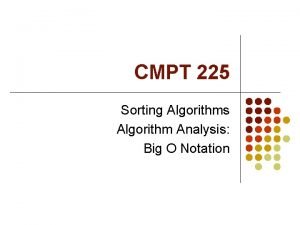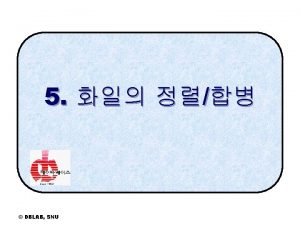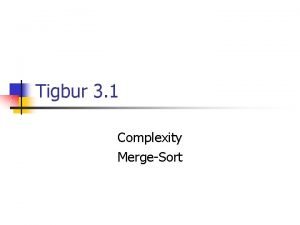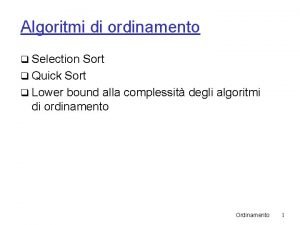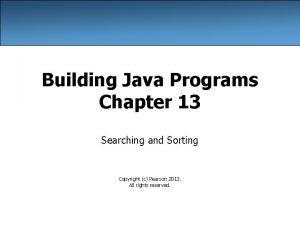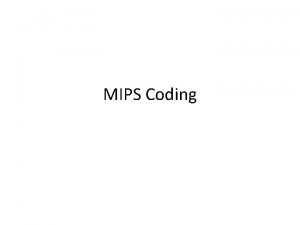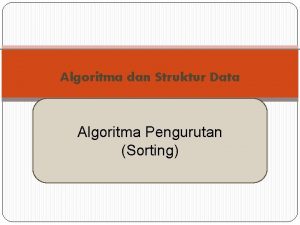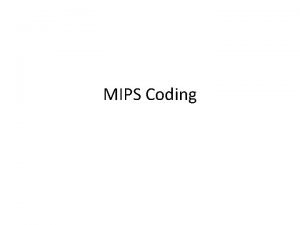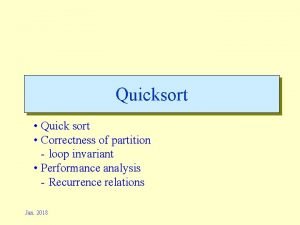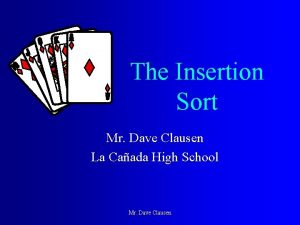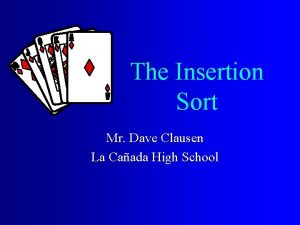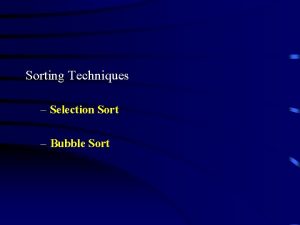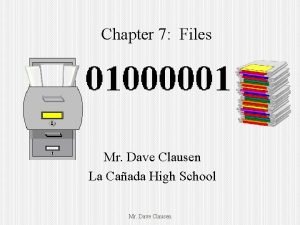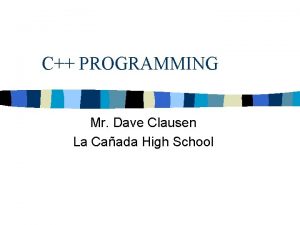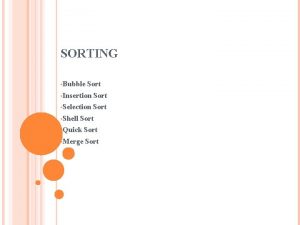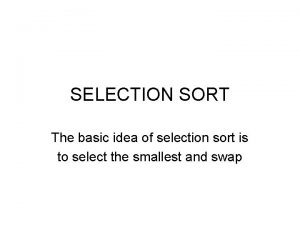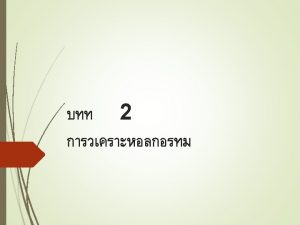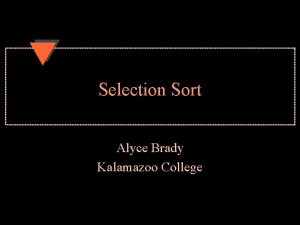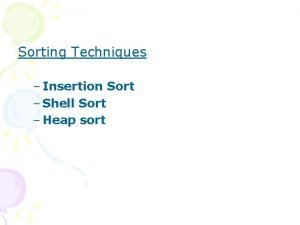The Selection Sort Mr Dave Clausen La Caada

































- Slides: 33

The Selection Sort Mr. Dave Clausen La Cañada High School

Objectives • Understand use the Selection Sort to sort data in a program. • Understand know Big-O notation for the Selection Sort. Mr. Dave Clausen 2

The Selection Sort Description The Selection Sort searches (linear search) all of the elements in a list until it finds the smallest element. It “swaps” this with the first element in the list. Next it finds the smallest of the remaining elements, and “swaps” it with the second element. Repeat this process until you compare only the last two elements in the list. Mr. Dave Clausen 3

The Selection Sort Algorithm • For each index position i – Find the smallest data value in the array from positions i through length - 1, where length is the number of data values stored. – Exchange (swap) the smallest value with the value at position i. Mr. Dave Clausen 4

A Selection Sort Example Smallest ? We start by searching for the smallest element in the List. Mr. Dave Clausen 5

A Selection Sort Example Smallest ? Mr. Dave Clausen 6

A Selection Sort Example Smallest ! Mr. Dave Clausen 7

A Selection Sort Example Swap Mr. Dave Clausen 8

A Selection Sort Example Swapped Mr. Dave Clausen 9

A Selection Sort Example Smallest ? After the smallest element is in the first position, we continue searching with the second element and look for the next smallest element. Mr. Dave Clausen 10

A Selection Sort Example Smallest ! In this special case, the next smallest element is in the second position already. Swapping keeps it in this position. Mr. Dave Clausen 11

A Selection Sort Example Swapped Swapping keeps it in this position. Mr. Dave Clausen 12

A Selection Sort Example Smallest ? After the next smallest element is in the second position, we continue searching with the third element and look for the next smallest element. Mr. Dave Clausen 13

A Selection Sort Example Smallest ! Mr. Dave Clausen 14

A Selection Sort Example Swap Mr. Dave Clausen 15

A Selection Sort Example Swapped Mr. Dave Clausen 16

A Selection Sort Example Smallest ? Mr. Dave Clausen 17

A Selection Sort Example Smallest ? Mr. Dave Clausen 18

A Selection Sort Example Smallest ! Mr. Dave Clausen 19

A Selection Sort Example Swap Mr. Dave Clausen 20

A Selection Sort Example Swapped Mr. Dave Clausen 21

A Selection Sort Example The last two elements are in order, so no swap is necessary. Mr. Dave Clausen 22

What “Swapping” Means TEMP 6 Place the first element into the Temporary Variable. Mr. Dave Clausen 23

What “Swapping” Means TEMP 6 Replace the first element with the value of the smallest element. Mr. Dave Clausen 24

What “Swapping” Means TEMP 6 Replace third element (in this example) with the Temporary Variable. Mr. Dave Clausen 25

C + + Examples of The Selection Sort Sample C++ Program For Selection Sort: sel_sort. cpp Animated Examples: Visual 1. exe Visual 1. cpp Visual 2. exe Visual 2. cpp On the Net: http: //compsci. exeter. edu/Winter 99/CS 320/Resources/sort. Demo. html http: //www. aist. go. jp/ETL/~suzaki/Algorithm. Animation/index. html Mr. Dave Clausen 26

C + + Code For Selection Sort void Selection_Sort (vector <int> & v) { int min_index = 0; for (int index = 0; index < v. size( ) - 1; ++index) { min_index = Find_Minimum (v, index); if (min_index ! = index) Swap_Data ( v [index], v [min_index]) } } // Selection_Sort Mr. Dave Clausen 27

C + + Code For Find Minimum int Find_Minimum (const vector <int> & v, int first) { int min_index = first; for (int index = first + 1; index < v. size( ); ++index) if ( v[index] < v[min_index]) min_index = index; return min_index; } // Find_Minimum Mr. Dave Clausen 28

C + + Code for Swap Procedure void Swap_Data (int &number 1, int &number 2) { int temp; temp = number 1; number 1 = number 2; number 2 = temp; } // End of Swap_Data function Mr. Dave Clausen 29

Pascal Code for Swap Procedure procedure Swap (var number 1, number 2: integer); var temp: integer; begin temp : = number 1; number 1 : = number 2; number 2 : = temp end; {Swap} Mr. Dave Clausen 30

Pascal Code For Selection Sort procedure Selection. Sort (var Int. Array: Int. Numbers); var element, Small. Index, index: integer; begin for element : = 1 to (Max. Num - 1) do begin Small. Index : = element; for index : = (element + 1) to Max. Num do if Int. Array [index] < Int. Array [Small. Index] then Small. Index : = index; Swap (Int. Array [element], Int. Array [Small. Index]) end; {Selection. Sort} Mr. Dave Clausen 31

BASIC Code For Selection Sort 8000 REM ######### 8010 REM Selection Sort 8020 REM ######### 8030 FOR ELEMENT = 1 TO MAXNUM - 1 8040 : : Small. Index = element 8050 : : FOR INDEX = (element + 1) TO MAXNUM 8060 : : : IF N (INDEX) < N (Small. Index) THEN Small. Index = INDEX 8070 : : NEXT INDEX 8080 : : TEMP = N (element) 8090 : : N (element) = N (Small. Index) 8100 : : N (Small. Index) = TEMP 8110 NEXT ELEMENT 8120 RETURN Mr. Dave Clausen 32

Big - O Notation Big - O notation is used to describe the efficiency of a search or sort. The actual time necessary to complete the sort varies according to the speed of your system. Big - O notation is an approximate mathematical formula to determine how many operations are necessary to perform the search or sort. The Big - O notation for the Selection Sort is O(n 2), because it takes approximately n 2 passes to sort the elements. Mr. Dave Clausen 33
 Java sequential search
Java sequential search Bubble sort vs selection sort
Bubble sort vs selection sort Bubble sort insertion sort
Bubble sort insertion sort Difference between selection sort and bubble sort
Difference between selection sort and bubble sort Who invented selection sort
Who invented selection sort Pseudocode adalah
Pseudocode adalah Selection sort vs bubble sort
Selection sort vs bubble sort Difference between insertion sort and bubble sort
Difference between insertion sort and bubble sort Karakterfremstilling
Karakterfremstilling Heinrich clausen
Heinrich clausen Caada moodle
Caada moodle Caada tree care
Caada tree care Caada moodle
Caada moodle Quick sort merge sort
Quick sort merge sort Radix sort animation
Radix sort animation Quick sort merge sort
Quick sort merge sort Radix bucket sort
Radix bucket sort Selection sort using recursion
Selection sort using recursion Insertion sort proof by induction
Insertion sort proof by induction Selection sort best case
Selection sort best case Selectionsort
Selectionsort Selection sort number of comparisons
Selection sort number of comparisons 대체선택 알고리즘
대체선택 알고리즘 Recurrence relation merge sort
Recurrence relation merge sort Recurrence relation of recursive selection sort
Recurrence relation of recursive selection sort Mips selection sort
Mips selection sort Selection sort algoritmo
Selection sort algoritmo Difference between selection and insertion sort
Difference between selection and insertion sort Sort popular
Sort popular Mips bubble sort
Mips bubble sort Urutkan
Urutkan Mips 버블정렬
Mips 버블정렬 Quicksort invariant
Quicksort invariant Selection vs bubble sort
Selection vs bubble sort

